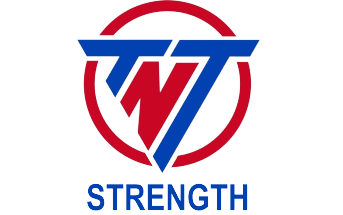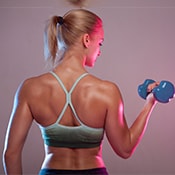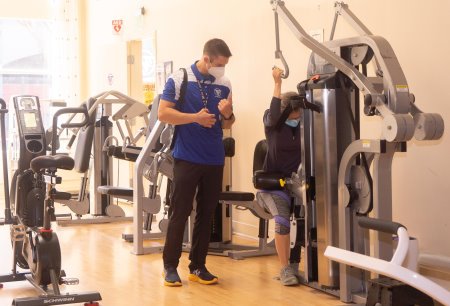
TAKU Doing an Over Head Squat with Woody Band
By TAKU
These days many of us are training at home, and need a way to get a decent workout without the luxury of the local gym.
Here at Truth Not Trends, we recognize that you can build strength with a wide variety of resistance devices. Muscle overload can be applied with various tools such as: barbells, dumbbells, machines, manually applied resistance, body weight, resistance bands, etc. Anything that can create high tension* in the muscles can be used.
We consider all the various devices as simply tools in our training toolbox. One of the most effective tools in our toolbox (especially for training at home) are resistance bands. Just as there are things a wrench can do that a hammer can’t, there are some things that make resistance bands more desirable than other methods of resistance. At T.N.T. we make sure our trainees learn the fundamentals of effective strength and conditioning training. Then they may pick the particular tool that will meet the need at hand in the most efficient way

TAKU doing a Lateral Lunge with Woody Band
Resistance Bands come in several varieties, and various configurations. For our purposes at T.N.T there are essentially two main types of Resistance Bands that we use. These are Bands with Handles ( We like JC Bands) , or “Sports Bands”, which are in one continuous loop (we like Woody Bands).
Here are a few of the advantages of Resistance Bands versus traditional weights or machines for in-home strength training:
1. Low Cost
2. Bands don’t take up much room.
3. Bands can’t smash your toe if you drop them
4. Bands can provide resistance in any plane of motion.
5. With most band systems you can quickly adjust the resistance level by changing to a heavier band or by shortening or lengthening your grip on a band or even doubling it up.
6. Bands offer a unique strength curve. The further you stretch a band the more resistance a band offers. In most movements your muscles are stronger when the limbs are near full extension. In these movement patterns a resistance band matches your strength curve better than free weights.
7. Resistance bands are portable and may be easily taken on a trip to provide a workout.

TAKU Doing a Standing Row with Woody Band
There may be other advantages, but these are a few of the most obvious. A good set of bands costs less than most one month gym memberships. They can be stored in your gym bag or hung up when not in use.
One of the coolest benefits is the ability to provide resistance in multiple planes of motion. Whether you have bands that are anchored to something or you hold the band is in each hand, you are able to work virtually any muscle at any angle. The potential applications are only really limited by your imagination.
For the above mentioned reasons (and many more) bands could be the answer to your home training needs.
Below I will introduce a simple pure resistance band workout, created by my friend coach Juan Carlos Santana from IHP. JC (as his friends call him) is one of my long-time mentors and one of the most talented and experienced strength coaches in the fitness industry. His company also happens to produce some of the best resistance bands available. Visit the store at IHP and take advantage of a special discount code created just for us here at T.N.T. Take a look at the awesome resistance bands and when you’re ready to check, out be sure to enter the code “TNT” to claim your discount.
How to Use Resistance Bands to Improve Strength
by Juan Carlos Santana:
The purpose of this is not to suggest that bands are all you need for comprehensive training. It is to provide various exercises we use to train various body movements. You can perform the entire workout or substitute any of these exercises with more traditional exercises. Experiment with this program and don’t be afraid to think outside the box.

Band resisted March
5-Minute Warm-up
Warming has become an unimportant ritual for many club exercises. However, it may be the most important part of the workout. This warm up is a general warm up in that it does not significantly involve upper body large resistance. But, it will increase core and muscle temperature so that you can go to a more specific warm up if you wish. Here is one of my favorites.
Instructions
Use a weightlifting belt (or other appropriate method of securing the band to the waist) Attach the band from a low attachment point behind you. This will not only add resistance to forward locomotion, but will add to the pull of gravity. Walk forward to add appropriate resistance
Notes:
You will be moving in a stationary manner – so use cones or other markers to stay within a safe area. You have to play around with this a bit before you become comfortable with how much resistance to use – be patient.
Protocol
Stationary Walk for 10 seconds and rest for 10 seconds X 3 – 1 minute
Stationary March for 10 seconds and rest for 10 seconds X 3 – 1 minute
Stationary Power Skip for 10 seconds and rest for 10 seconds X 3 – 1 minute
Stationary Run for 10 seconds and rest for 10 seconds X 6 – 2 minute
Notes: Make sure you use high knees and stay on the balls of your feet whenever possible. The more powerful you make these movements, the more they will transfer to your everyday life.
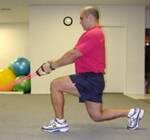
Band resisted forward Lunge
BAND RESISTED FORWARD LUNGES-
When working the lower body, lunges are one of my favorite exercises. They are particularly effective at training deceleration and changes in direction. Since the warm-up section focused on going forward, the lunges provide excellent deceleration training.
Instructions
Use a weightlifting belt (or other appropriate method of securing the band to the waist) or use handles and hold the resistance with the hands (shown in picture). Attach the band from to a low attachment point in front of you. This will add to the forward momentum and to the pull of gravity. Holding onto the handles, walk back to add appropriate resistance and space for forward lunging. Stand straight and take a long step forward. Keep the body erect and core tight. Land with a full foot and lower your body to a lunge position. Explode back to a standing position. Repeat with other foot.
We perform anywhere from 1-3 sets X 8-15 reps of this exercise within a single workout.
Notes: There are several types of lunges you can perform. One of our favorite advanced versions is the reaching lunge. Follow the above instructions but reach forward as you lunge
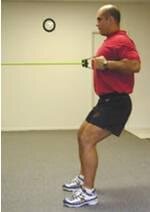
Standing Row
Standing Pulls – Upper body
Standing pulls are an excellent way to work the total body while emphasizing the posterior back musculature. They provide balance and stability training while pulling. In real life we always pull from our feet, therefore, the standing pull is one of the most functional exercises we perform.
Instructions
Attach the band or pulley to a low or mid attachment point in front of you. We prefer the low orientation since it is the most functional. Holding onto the handles, walk back to add appropriate resistance and space for the pulling motion. Stand straight and keep the body erect and core tight. Keep knees slightly bent and center of gravity lower then normal. Pull the cables or pulley handles to you as if you were doing a cable row. You can use simultaneous or alternating pulling patterns.
We perform anywhere from 1-3 sets X 8-15 reps of this exercise within a single workout. Notes: There are several types of pulls you can perform. You can even add a forward reach to the movement, creating a compound row. With the alternating version, you can add foot pivots to further focus on hip rotation. The single leg version of this exercise is also very challenging.
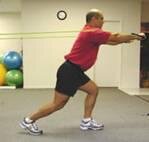
Standing Push
Standing Push
Standing presses are an excellent way to work the total body while emphasizing the pressing or pushing motion. This exercise provides balance and stability training while pushing forward. In real life we usually push from a standing position, therefore, the standing press is very functional.
Instructions
Attach the band behind you, from a low or mid attachment point. We prefer the mid orientation to emphasize the core and a forward lean position. However, the low orientation is effective for focusing on the pressing movement. Holding onto the handles, walk forward to add appropriate resistance and space for the pressing motion. Stand straight and keep the body erect and core tight. We prefer the staggered stance since it provides more stability to the line of pull. (see picture)Press the Bands handles as if you were doing a bench press. You can also use the alternating pushing pattern, which resembles more a punching action.
We perform anywhere from 1-3 sets X 8-15 reps of this exercise within a single workout.
Notes: There are several types of presses you can perform. You can even add a forward step to the movement, creating a thrusting action. The single leg version of this exercise is also very challenging.
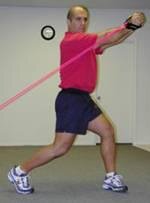
Band Lo / Hi Chop
Standing Chops
Standing Low-Hi Chop are an excellent multi-planar core exercise. This exercise emphasizes the extension mechanism, but with a rotational component. Sports, such as tennis and golf, use portions of this movement – making this exercise very popular with our athletes and recreational sport participants.
Instructions
Attach the band to your side, from a low attachment point.
Holding onto one handle with both hands, walk away from the point of attachment to add appropriate resistance and space for the extension movement. Stand straight and keep the body erect and core tight. We prefer the parallel stance since it provides more stability to the line of pull. Keep the arms straight and locked out in front of your chest. Rotate and flex down towards the point of the attachment, reaching down to load the body. Use a foot pivot on the outside leg during the downward flexion and rotation. This will allow maximum utilization of the entire body. Rotate and extend away from the point of attachment, keeping your arms locked out and in front of your chest at all times. Pivot on the inside foot as you rotated away from the resistance (see picture).
We perform anywhere from 1-3 sets X 8-15 reps of this exercise within a single workout.
Notes: You can also perform the opposite version of this exercise to train rotation and flexion. Use a high orientation of pull and chop downward as you rotate.
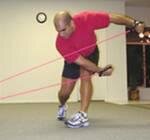
ABC CRUNCH
Standing ABC Crunch
Standing ABC Crunches offer excellent flexion training for the front of the body, while addressing flexibility of the posterior chain. The ABC pattern provides multi-planar training, especially for the hips.
Instructions
Attach the band in front of you, from a mid or high attachment point.
Holding on the handles, walk away from the point of attachment to add appropriate resistance and space for the crunch movement. Stand straight and keep the body erect and core tight. We prefer the parallel stance since it provides more stability for the rotational patterns of the ABC. Keep the arms straight and locked out in front of you – at shoulder level. Flex down as if performing a crunch while pulling down and in, until the band touches the shoulders. Come back up to the standing position. This is the “C” pattern.
For the “A” and “B” patterns, flex down as if performing a crunch while rotating and pivoting the foot on the opposite side of the crunch (see picture). This will bring the bands to the outside of the planted leg. Come back to the standing position and perform to the other side. The foot pivots during the rotation and flexion really target the hips.
We perform anywhere from 3-5 sets X 8-15 reps of this exercise within a single workout.
Notes: You can also perform the opposite version of this exercise to train rotation and extension. Use a low point of attachment – pulling and extending as you rotate. Use the same ABC pattern for multi-planar training.
Performing this simple workout will allow you to see improvements in the way you feel and move. You can also include some of these exercises into your traditional workouts for added fun and training efficiency. This workout can be performed in succession, in sequence or as a circuit for additional cardiovascular training.
TAKU’s NOTE:* Creating high tension in the muscle fibers and working to momentary muscular failure involves the greatest amount of relative muscle tissue. Effort (working to fatigue) and using good form (controlled movement with no bouncing or jerking) are important here. If in doubt, slow it down and aim for maximum repetitions (safely).
TNT has over 35 years of combined fitness experience, so if you’re looking for a coach who can train you online from anywhere in the world, visit our online training page to book a consultation.
TNT wants you to maximize your strength as safely and efficiently as possible, so if you’re looking for a stand alone workout plan, check out our Blackjack training program.
